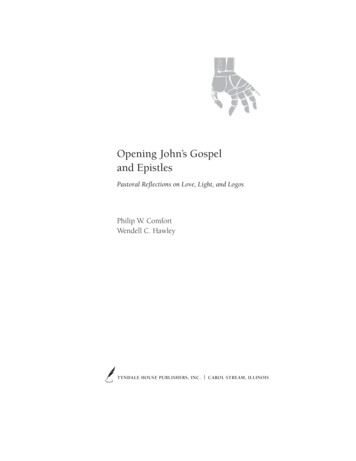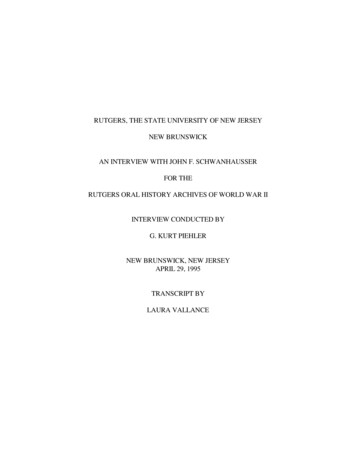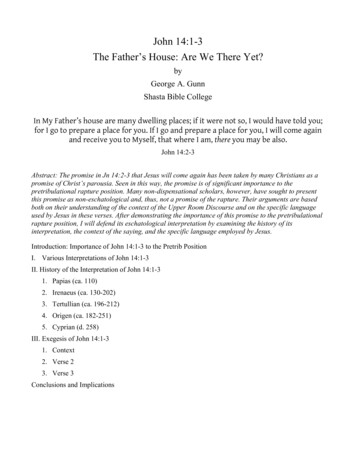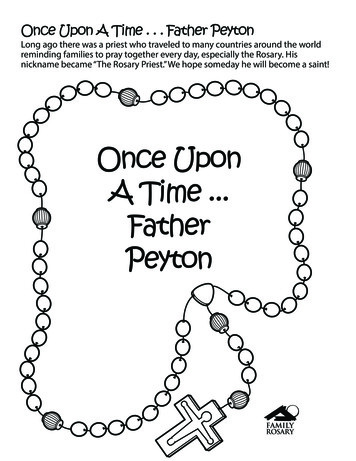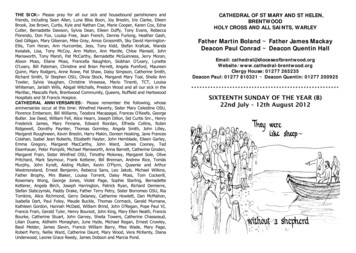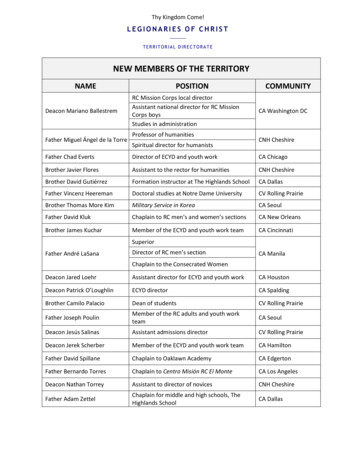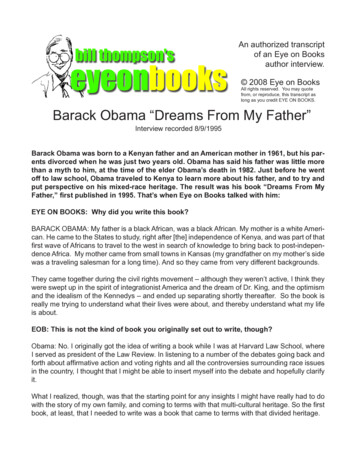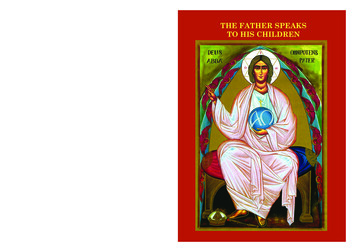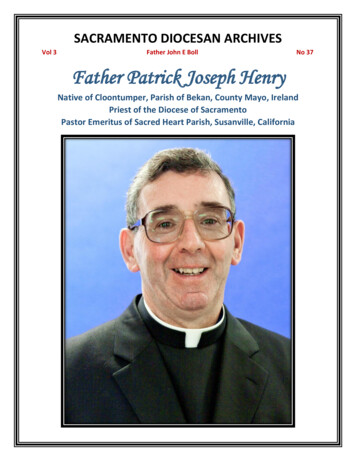
Transcription
SACRAMENTO DIOCESAN ARCHIVESVol 3Father John E BollNo 37Father Patrick Joseph HenryNative of Cloontumper, Parish of Bekan, County Mayo, IrelandPriest of the Diocese of SacramentoPastor Emeritus of Sacred Heart Parish, Susanville, California
Patrick Joseph Henry, son of John Henry and Mary Waldron, is the oldest of five children. Thechildren of the Henry family are, in order of birth, Patrick, Maureen, Sean, Bridget and Rita.Patrick was born in the family home on the Feast of Saint Joseph, March 19, 1948, in the Villageof Cloontumper, Parish of Bekan, County Mayo, six miles from the Shrine of Knock.There is a tradition of faith in the village that Father Jordan, who was martyred in 1649, hadcelebrated Mass regularly at a “Mass Rock” a half mile from the Henry family home. People wereinspired by Father Jordan’s witness to the Catholic faith in times of persecution in Ireland.Courtesy of Fr HenryA Book about the Life of Father Jordan2
Patrick says his family was poor. His father John was a farmer who raised cattle andplanted crops. He provided food for the family and sold the surplus at the local market.When Patrick’s father John was a youth, his father Patrick died of cancer and John wasforced to leave school at age of 14 to assist his mother in managing the farm. In 1960, atthe age of 48, Patrick’s father John also died of cancer when Patrick was just twelve yearsof age. Patrick’s mother Mary became a widow at the age of 32 and had to manage thefarm and raise her five children on her own until she remarried a couple years later.PATRICK BEGINS SCHOOLPatrick began primary school at the National School in Bekan and attended there for eightyears. He then transferred to Saint Jarlath’s College in Tuam, County Galway, for highschool from 1962-1967. This school was operated by the Archdiocese of Tuam and had18 diocesan priests serving as teachers and administrators. Saint Jarlath’s College had areputation for football, but Patrick did not play football. The school also had a programfor provincial and national athletics. Patrick was a good runner but did not qualify for theschool team. He graduated from Saint Jarlath’s College in 1967.Photo from St Jarlath’s College WebsiteSaint Jarlath’s College, Tuam, IrelandJOINS THE SOCIETY OF SAINT COLUMBANAfter high school, Patrick joined the Society of Saint Columban in Navan, CountyMeath. The co-founder of the Society, Father John Blowick, was still living and wasan inspiration to the members of the Saint Columban Society. However, after twoyears, Patrick decided he was not ready to continue with his studies so he left theSociety and went to England to work.3
Photo from Society of St Columban, Ireland WebsiteHome of the Missionary Society of St Columban, Dalgan Park, Navan, County Meath, IrelandYEARS IN ENGLANDIn 1969, Patrick left for London and spent three years working at different jobs when he decidedto pursue further studies. He was accepted by the Newman College of Education, part of theUniversity of Birmingham, to study for a Bachelor of Education degree. After qualifying as ateacher, he taught for twelve years at three different schools in Birmingham and became headof the Department of Music and Special Education at two of these schools.STUDIES FOR A DEGREE IN PHILOSOPHY AND MUSICDuring those twelve years, Patrick continued his studied for a second degree in philosophy and music atthe Open University. He auditioned for the choir of the Metropolitan Cathedral Church of Saint Chad inBirmingham and had the privilege of being a choral vicar for eight years. There were two excellentdirectors of music; the first had been a chorister at King’s College, Cambridge, who was an outstandingdirector of choirs. This former chorister is now manager of the Royal School of Church Music in Londonand has been honored by Queen Elizabeth II of England.The second director of music is still at the Metropolitan Cathedral Church of Saint Chad in Birminghamand is also professor of music locally. It was a wonderful time for Patrick as he learned much about musicin general and choral music in particular.When Patrick was a Cathedral singer, the choir toured the Archdiocese of Birmingham, broadcastedservices for the BBC, and went on tour to various cities in Europe. He remembers especially the RhinelandTours of southern Germany. Since then, Patrick has not sung in a church choir for 35 years and has lostsome of the skills he had developed in his earlier years.4
Photo courtesy of Fr HenrySaint Chad’s Cathedral Choir, Birmingham, England5
THE CATHEDRAL CHURCH OF ST CHADThe Cathedral of Saint Chad was the first neo-Gothic Cathedral built by the architect AugustusWelby Northmore Pugin in the middle of the 19th century. The building of this Cathedral coincidedwith the restoration of the English Roman Catholic Hierarchy after decades of suppression by theCrown. This was also the time when John Henry Newman came to Birmingham and he was veryfamiliar with the Cathedral. Newman founded the Oratorians and resided at a church about amile away from the Cathedral. This Cathedral is famous for its beautiful stained glass windowsthat were recently restored to their original beauty.Photo taken from St Chad Cathedral WebsiteMetropolitan Cathedral Church of Saint Chad, Birmingham, EnglandPREPARATION FOR MINISTRYDuring his eight years as a Cathedral singer and as a semi-professional singer, Patrick wasalso involved in Hospice as a volunteer. The primary purpose of Hospice was to preparethe terminally-ill patients for death. Patrick was also involved in fundraising for theHospice Movement by means of its thrift stores and was a voluntary receptionist forHospice. In the local parish, Patrick was a member of the Society of Saint Vincent de Pauland visited people who lived in the Inner-Ring of the City of Birmingham.6
RETURN TO THE SEMINARYWhile Patrick was a member of the Saint Vincent de Paul Society and Hospice, his faith in Godand love for the Church continued to grow. As a result of singing the Sacred Texts of Scripture atthe Cathedral, he began to pray the Divine Office of the Church. He remembers clearly that duringthe Easter Vigil in 1984, while the choir was singing the Reading Rota (Perspice Christicola, c 1270)at the Cathedral, he came to the conviction that God was calling him to become a priest. Also,during the singing of one of the psalms that same night, Patrick decided he would makeapplication to the seminary.During this same period, Patrick owned his own home near the burial site of Blessed John HenryNewman. He visited Newman’s grave regularly and also his living quarters at the Oratory onHagley Road in Birmingham before this place became famous following the visit of Pope BenedictXVI when he visited England in 2012.Photo by T E Martin, Cardinal Newman WebsiteSaint John Henry Newman’s Sarcophagus, Church of the Birmingham Oratory, EnglandThe life and work of Blessed John Henry Newman began to exert an influence in Patrick’s life. Hewould visit Oriel College at Oxford University every year, because Newman was still rememberedthere. He also visited the Church of Saint Mary the Virgin, the place where the Oxford Movementbegan. However, Patrick waited almost a year before applying to the seminary.7
Saint John Henry Cardinal Newman8
APPIES TO THE SEMINARYWhen Patrick applied to the Archdiocese of Birmingham to enter the seminary, he was 37 years of ageand was told by the Director of Vocations that he was too old. Undaunted, Patrick next applied to theDiocese of Menevia in Wales. He learned the Welsh language as part of his acculturation after he wasaccepted by Bishop James Hannigan, bishop of Menevia. Bishop Hannigan sent Patrick to Saint Kieran’sCollege in Kilkenny in 1985 where he studied theology for four years.Photo from the St Kieran College WebsiteSaint Kieran’s College, Kilkenny, IrelandIn 1989, the Diocese of Menevia and the Archdiocese of Cardiff decided together that a thirddiocese in Wales needed to be created. Part of the Diocese of Menevia and part of theArchdiocese of Cardiff became the new Diocese of Wrexham near Chester City. Bishop Hanniganof the Diocese of Menevia became the bishop of the new Diocese of Wrexham and asked Patrickin which diocese he preferred to serve. Patrick said he would like to join the Diocese of Wrexhamand Bishop Hannigan accepted him as a seminarian for the Wrexham diocese.Once the new diocese was created, Bishop Hannigan realized he had only four parishes thatneeded a parochial vicar and he had eight seminarians younger than Patrick that were close toordination. The bishop decided that, given Patrick’s age, he was not really needed in the newdiocese. He asked Patrick to apply to another diocese and he would support Patrick’s application.9
PATRICK CHOOSES THE DIOCESE OF SACRAMENTOPatrick was approaching deaconate and had to beaccepted by a diocese in order to be ordained a deacon.Because he had cousins on his father’s side of the familyliving in Sacramento and in the San Francisco Bay area, heapplied to the Diocese of Sacramento.Bishop Francis Quinn was the bishop of Sacramento andhappily accepted Patrick as a seminarian for the Dioceseof Sacramento.Bishop Francis A QuinnSENT TO SACRED HEART SEMINARY IN MILWAUKEEAfter arriving in Sacramento, Bishop Quinn sent Patrick to Sacred Heart Seminary in Milwaukeeto complete his studies. He joined three other Sacramento seminarians Keith Canterbury, TerryFulton and Mike Hebda and spent one year at Sacred Heart Seminary before returning toSacramento for the mandatory pastoral year.Photo from the Sacred Heart Seminary WebsiteSacred Heart Seminary, Hales Corner, Wisconsin10
PASTORAL YEAR IN FOLSOMFor his pastoral year, Patrick was assigned to Saint John theBaptist Church in Folsom. During that year, he assisted withreligious education in the parish. He says that his pastor, FatherWilliam Kinane, was an inspiration to him because he showedhim how to interact with parishioners in a meaningful way,mindful of the spirit and hospitality of the Gospel.Wednesdays were Father Kinane’s day off and as he left to playgolf he always knocked on Patrick’s door to invite him to join thegolf group for dinner that evening. Father Kinane was alwayshospitable, kind and thoughtful to Patrick which he greatlyappreciated.Father Bill KinaneORDINATION TO THE DIACONATEPatrick Henry was ordained a deacon in January 1992 at Saint Mary Cathedral in San Franciscobecause it was Bishop Francis Quinn’s turn to ordain the transitional deacons of Saint PatrickSeminary that year at Saint Mary Cathedral.Photo by John E BollSaint Mary Cathedral, San Francisco11
ORDAINED A PRIEST FOR SACRAMENTOAt the end of his pastoral year, Patrick J Henry was ordained a priest for the Diocese ofSacramento on June 7, 1992 in the Cathedral of the Blessed Sacrament by Bishop Francis A Quinn.Ordained with him that day as priests were R Francis Stevens and Charles Nguyen.Photo by John E BollCathedral of the Blessed Sacrament where Father Patrick was OrdainedA week after his ordination,Father Patrick returned to Irelandto celebrate Mass at his homeparish with Mary his mother andhis brother and sisters as well asthe whole parish community ofCloontumper who celebrated theordination of one of its own nativesons.It was a time of excitement for theparish because there had notbeen an ordination from thatparish for 38 years.Photo courtesy of Fr HenryFather Patrick Celebrates his Ordination with his Home Parish in Ireland12
FIRST APPOINTMENT, SAINT PATRICK PARISH, PLACERVILLEFather Patrick’s first appointment was as parochial vicar to Saint Patrick Parish in Placerville withFather Anthony Gurnell as pastor. This appointment lasted only 14 months but during his time inPlacerville he learned a great deal about parish life and the American culture from the people ofthe parish.Photo by John E BollSaint Patrick Church, PlacervilleAt the end of fourteen months in Placerville, Bishop Quinn appointed Father Patrick parish administratorof Holy Cross Parish in Tulelake. This was the time of the inter-regnum of Bishop Quinn who was retiringand Bishop Weigand who was appointed as his successor. Father Patrick was appointed administrator byBishop Quinn for six weeks and subsequently named pastor of Tulelake by Bishop Weigand.PASTOR OF TULELAKEFather Michael Tamburi died suddenly at his office desk in the parish rectory at Tulelake onOctober 21, 1993, leaving the parish without a pastor. Thanks to the confidence placed in him byBishop Weigand, Father Patrick quickly learned how to do the parish bookkeeping and managethe parish. ”It was,” he said, “a baptism by immersion.”Thanks to his previous experience of living in extremely cold weather in Wisconsin, Father Patrickwas able to deal with the very cold weather in Tulelake during the winter months. Throughouthis six years as pastor of Holy Cross Parish, his focus was primarily on developing the parish13
Hispanic ministry because the majority of the parish community was now Hispanic since many ofthe original homesteaders were aging and passing on to the Lord.Photo by John E BollHoly Cross Church, TulelakeOne of the main struggles Father Patrick had to deal with in the parish was the lack of finances.He saved money by cleaning his own house, cooking his own meals, serving as his own secretaryand bookkeeper, and doing much of the maintenance work on the parish facilities himself.Half way through his six years in Tulelake, Bishop Weigand sent Father Patrick to Guadalajara,Mexico to study Spanish for six weeks. This short time of study increased his interest in theSpanish language and working with the Hispanic communities in this parish and in other parishesthat would follow his assignment in Tulelake.Many people have never been to Tulelake because this parish is one of the most remote in thediocese, but the beauty of the area is stunning. The Great Basin of Tulelake is a rich agricultural areawhere farmers grow such crops as sunflowers, wheat, barley, alfalfa, peppermint, onions and thefamous Tulelake potatoes known around the world. Tulelake was also known as the “HorseradishCapital of the World” and used to account for a third or more of the nation’s production. Followingare some photos of the Tulelake area so you can appreciate the beauty of the area. These photoswere taken by Father John E Boll in July 2013 when he filled in at the parish for five weeks.14
15
16
17
18
19
NEXT PARISH, ALTURASIn 2000, Father Henry was given a new assignment as pastor of Sacred Heart Parish inAlturas. Alturas is 315 miles from Sacramento and a five hours and fifteen minute drivefrom Sacramento to Alturas. Father Henry succeeded Father Rodney Hall who had beenpastor of Alturas for the six prior years. Father Rodney left the Alturas parish in very goodadministrative condition.Photo by John E BollSacred Heart Church, AlturasFather Patrick wanted to develop a Hispanic ministry in the parish but because Hispanicparishioners were scattered throughout Modoc County, his efforts were not very successful.However, the Hispanic community came out in great numbers for the Feast of Our Lady ofGuadalupe. In wintertime, parishioners could not attend Mass often because of the weather andicy roads. Alturas averages 13 inches of rainfall a year and an average of 28 inches of snow.The driving distance from Alturas to the parish Mission Church of Saint James in Cedarville is 27miles and the road winds through the Warner Mountain Range. Driving through the mountainpass at night in winter is very dangerous because of the black ice on the road. Over the years,some priests slid off the road in the wintertime on their way to Cedarville.For Father Patrick, the Alturas parish community was straight forward, pleasant and parishionerswere very good at fundraising to help pay parish bills.20
Photo by John E BollSaint James Mission Church, CedarvilleNEXT PASTORATE, SACRED HEART PARISH, ANDERSONAfter six years in Alturas, Bishop Weigand appointed Father Henry pastor of Sacred Heart Parish inAnderson in 2006. This assignment was a short year and a half because Bishop Weigand asked FatherPatrick to make a lateral change with the pastor of Susanville who could no longer deal with the highaltitude there and needed to move to a parish with a lower elevation.Photo by John E BollSacred Heart Church, Anderson21
SACRED HEART PARISH, SUSANVILLEIn 2008, Father Patrick made the lateral transfer to Sacred Heart Parish in Susanville where he spent threeand a half years. While pastor there, he started a Scripture study program which parishioners enjoyedbecause they learned a lot about the Sacred Scriptures.Photo by John E BollSacred Heart Church, SusanvilleTHE SUSANVILLE CHURCH CATCHES FIREOne Saturday morning, the furnace in the Susanville church caught fire and the fire and smoke did asignificant amount of damage to the interior of the church. The stained glass windows had to beprofessionally cleaned, the floors were replaced, a new sound system installed and the interior of thechurch was painted. While the church was being restored, Mass was celebrated in the parish hall acrossthe street from the church. Luckily, the insurance covered the entire cost of the church restoration.During this pastorate, Father Patrick began to celebrate the Simbang Gabi Novena before Christmas as away to draw Filipino Catholics back to the practice of their faith. At the same time, he found the Hispanicministry in Susanville to be very successful.SENT TO MACC IN SAN ANTONIODuring his three and a half years in Susanville, Bishop Soto became the new bishop of Sacramentoand decided to send Father Patrick on a sabbatical study program. Father Patrick decided toattend the MACC Program in San Antonio, Texas. During his time there, he studied Mexicanculture and improved his Spanish speaking ability. He also studied the writings of Father VirgilElizondo who was an influential Hispanic priest in San Antonio at that time. Father Patrick foundhis studies at the MACC Center to be a positive experience.22
Photo by John E BollMEXICAN AMERICAN CATHOLIC COLLEGE (MACC), SAN ANTONIO, TEXASSAINT CHARLES PARISH, SACRAMENTOUpon his return to the Diocese of Sacramento in 2012, Father Henry was assigned as parochial vicar of Saint CharlesBorromeo Parish in Sacramento and served there for two years and then retired from active ministry in 2014.Photo by John E BollSaint Charles Church, Sacramento23
During his time at Saint Charles parish, he became very frightened by the violence in the area. Local gangs wereactive and especially violent at night. He says he often heard gun shots ring out during the night which resulted inthe killing of rival gang members. This was a frightening time, especially if he or another priest had to make anemergency call to a local hospital in the middle of the night.RETIREMENTBishop Jaime Soto gave his permission to Father Patrick to retire on June30, 2014. He moved to Saint Thomas More Parish in Paradise where herented the lower ground floor apartment at the new rectory.He lived in Paradise for two and a half years because the bishop hoped aretired priest would live in the northern part of the diocese to beavailable to assist pastors as needed. Father Patrick accommodatedhimself to Bishop Soto’s wish and that is why he moved to Paradise.Bishop Jaime SotoMOVE TO THE PRIESTS’ RETIREMENT VILLAGEIn 2016, Father Henry decided to return to the Sacramento area and moved into the apartmentvacated by Father John Sullivan who had moved to Senior Housing in mid-town Sacramento.Photo by John E BollFather Patrick’s Apartment in the Priests’ Retirement Village, Citrus Heights24
Since his retirement, Father Henry says he has had the privilege of serving in many parishesthroughout the diocese during the past six years.” It has been an honor,” he says, “to serve theparishes of the diocese at the invitation of the pastors.” He likes to fill in at parishes for anextended period of time, especially when a pastor wishes to take a sabbatical.Father Patrick wishes to thank everyone, including his parents, grandparents, people in England,both clergy and laity, his seminary professors, Father William P Kinane who was pastor during hispastoral year, and all the priest of the Diocese of Sacramento to whom he owes thanks for all hehas learned about ministry to this point in his life’s journey.FINAL THOUGHTSFor Patrick Joseph Henry, the call to priesthood was a gradual process over a number of years. Losing hisfather John to cancer when Patrick was only 12. As the eldest of a family of five children, the death of hisfather was a heavy and painful load for him to carry.Although Patrick’s father John had to leave school at age 14 when his father Patrick died in 1930, Johnwas a gifted man with a keen intelligence who always encouraged his own children to continue theirstudies and to develop a love and appreciation for music and poetry. These lofty hopes were fulfilled inthe life of his eldest son Patrick.After high school and two years with the Society of Saint Columban, Patrick’s experience in London as amember of the Cathedral Singers of Saint Chad Cathedral in Birmingham eventually led him to accept andembrace God’s call to him to become a priest.We can sum up Patrick’s life by the phrase, “God writes straight with crooked lines.” In his life of ministry,he has had some unexpected turn of events but through it all, he has remained faithful to his call to be apriest with a spirit of hope, joy and service. Even today, when a brother priest calls Father Patrick to seeif he can help in a parish, he always responds yes to their call if he is not committed to another parish atthe same time.In his retirement, Father Patrick enjoys serving as chaplain on pilgrimages to holy sites around the world.He has also served at the Knock Shrine in Ireland in the summer and fills in at parishes in the Sacramentodiocese as well as in the Diocese of Phoenix. Often, he is not at home in Citrus Heights because he ishelping in a parish or serving as chaplain on a pilgrimage to Israel, Rome, Spain, France or Ireland.Father Patrick is grateful to God for the many blessings he has received in his life of ministry and we aregrateful to him for giving the best years of his life to the People of God in the Diocese of Sacramento.Father Patrick, we wish you good health and many happy adventures as you move forward to the fullnessof life in the Kingdom of God. As Padre Serra often said, Siempre Adelante!Ad Multos Annos!25
SHRINE OF OUR LADY OF KNOCK, IRELANDPhotos taken from Our Lady of Knock Shrine Website26
Father Patrick Joseph Henry’s familyMary Waldron HenryFather Patrick’s MotherRIP27
Patrick Joseph HenrySean, brotherRIPMaureen, sisterRita, sisterPhoto not available28Bridget, sister
Father Patrick Joseph Henry29
PATRICK BEGINS SCHOOL Patrick began primary school at the National School in Bekan and attended there for eight years. He then transferred to Saint Jarlath's ollege in Tuam, County Galway, for high school from 1962-1967. This school was operated by the Archdiocese of Tuam and had 18 diocesan priests serving as teachers and administrators.


